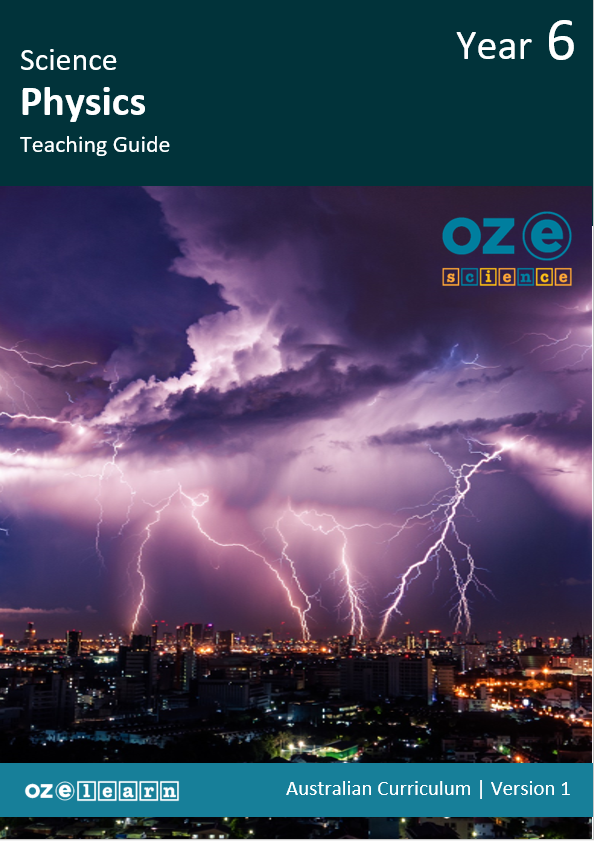Oz-e-science
Physics - Year 6
Overview
Physics Year 6 is the study of how the total amount of energy in the universe is always the same but energy can be transformed when things change or are made to happen. It aligns to the Australian Curriculum Science Understanding:
Note: This curriculum program is currently being updated to align with the Australian Curriculum 9.0. Updated versions will be released in early 2024.
- Electrical energy can be transferred and transformed in electrical circuits and can be generated from a range of sources (ACSSU097).
Note: This curriculum program is currently being updated to align with the Australian Curriculum 9.0. Updated versions will be released in early 2024.
Learning Objectives
In lessons 1 to 9, students learn about:
- different types of energy
- how energy can be transferred from one place to another
- how one kind of energy can be transformed into a different kind of energy
- electrical energy and the renewable and nonrenewable sources it comes from
- electric currents and static electricity
- conductors and insulators
- the parts that make up an electrical circuit
- how to conduct an investigation to find out which renewable energy source would be best for your town
- presenting our findings about which renewable energy source would be best for your town.
Success Criteria
- Explain what energy is.
- Describe six different types of energy.
- Observe energy forms in the school.
- Describe examples of how energy is transferred.
- Represent energy transfer using everyday items.
- Describe examples of how energy is transformed.
- Sort examples of energy transfer and transformation in a card game.
- Explain how electrical energy is generated.
- Identify three fossil fuels that are used to generate electrical energy.
- Identify three sources of renewable energy that are transformed to generate electrical energy.
- Explain how electrical energy moves as static electricity.
- Explain how electrical energy moves as an electric current.
- Investigate the effect of static electricity on different objects.
- Explain what makes a material a conductor or an insulator.
- Identify materials as insulators or conductors using a simple circuit.
- Explain what an electrical circuit is.
- Identify a complete circuit.
- Build a simple circuit.
- Form a hypothesis.
- Ask scientific questions.
- Conduct research.
- Analyse and evaluate.
- Explain your results.
- Communicate which renewable energy you would use in your town.
Assessment
Progress Tests
Progress tests are conducted after every second lesson, allowing teachers to monitor student understanding of the concepts taught over the past two lessons and to identify where reteaching is needed. The Teaching Guide contains the testing questions, and the Student Workbook has a section where students write their answers and score themselves.
Structured Research Activity
The Structured Research Activity (SRA) for this unit is: Students to conduct an investigation and presenting their findings on which renewable energy source would be best for their town. The SRA takes place over two lessons so students can apply the Science Understanding and Science Inquiry Skills covered in the unit. Teachers use the Guide to Making Judgements, which is included in the Teaching Guide, to mark the SRA.
End-of-Unit Assessment
The last lesson is the end-of-unit assessment which has a variety of question formats (e.g. label the diagram, circle the correct answer) to assess student mastery of content from the unit.
Progress tests are conducted after every second lesson, allowing teachers to monitor student understanding of the concepts taught over the past two lessons and to identify where reteaching is needed. The Teaching Guide contains the testing questions, and the Student Workbook has a section where students write their answers and score themselves.
Structured Research Activity
The Structured Research Activity (SRA) for this unit is: Students to conduct an investigation and presenting their findings on which renewable energy source would be best for their town. The SRA takes place over two lessons so students can apply the Science Understanding and Science Inquiry Skills covered in the unit. Teachers use the Guide to Making Judgements, which is included in the Teaching Guide, to mark the SRA.
End-of-Unit Assessment
The last lesson is the end-of-unit assessment which has a variety of question formats (e.g. label the diagram, circle the correct answer) to assess student mastery of content from the unit.
Recommended Units
Baninh Yeeum Building 302-310 Sheridan Street, Cairns QLD 4870
PO BOX 278, North Cairns QLD 4870
Phone: 1800 00 GGSA (4472)
info@goodtogreatschools.org.au
Empty space, drag to resize
Subscribe to our newsletter
Thank you!
Empty space, drag to resize
2023 All Rights Reserved
Write your awesome label here.
Write your awesome label here.
Write your awesome label here.
Subscribe to our newsletter now!
Get weekly updates on live streams, news and more right in your mailbox.
Thank you!
Write your awesome label here.
Write your awesome label here.
Planned 24 Hour Maintenance
Website Temporary Unavailable
10AM 05 January until 10AM 06 January 2024
Dear school teams
You will not be able to access your content during this time. We will be busy loading all the new enhancements you asked for. We are confident you will be delighted with the new features we have designed for you! Please join on Saturday after 10:00am to try them out!
School Partnerships Team


